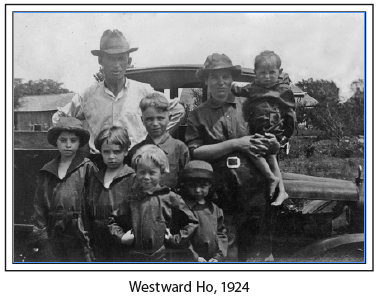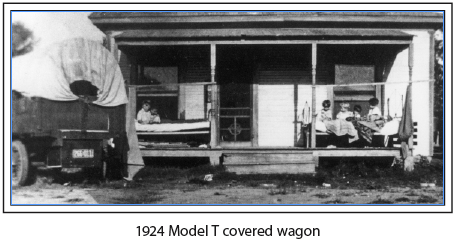Excerpts from a chapter...
We are getting ready to start on our great adventure. The home and what is in it is sold. We are going in a Ford truck with our clothes and a camp outfit to see the world and conquer, not the world, but hard times.
This was the entry in my mother’s diary at 7:00 a.m. on Wednesday, July 16, 1924. When she wrote of hard times, I know she was remembering how hard it had been to feed a family with six children on a dollar a day. She had mentioned it often as we were growing up.

I cherish the family group photo taken on the day we left Shawnee, Oklahoma to go to California. What might each have been thinking and feeling as they posed? Did they all think this would be a great adventure? Dad stands with his hands braced against the side of the truck behind us. I would like to think he felt some determination or resolve, but he seems to be just waiting for the picture taking to be over. He was not a big man, but he looks tall compared to our mother who stands five-feet and two-inches tall beside him. They are both 35 years old.
Mama’s small smile seems brave but rather tentative. The shadow cast by the brim of her hat veils the expression in her eyes. She is holding me, the youngest of her brood just two years old. I’m squinting into the sun. Do I understand what is happening? Probably not. The oft-told stories of the trip only seem like memories.
I can’t tell much from my brother’s face either. Wilbur’s twelfth birthday had been the week before. He once told me that he was glad enough to be leaving Shawnee, Oklahoma because it meant not going to school for a while. He didn’t like school. He was smaller than most other boys his age and wore glasses, an easy target for schoolyard bullies.
Ten-year-old Edith was named for my mother, but we always called her Sister or just Sis. In the picture, she looks as sad as if she has just lost her best friend. She probably feels she has. Eighty years later, she still remembers how she had grieved a long time over the separation from her first cousin, Pauline.
Ruth looks healthy enough in this picture when she was eight years old, but she had almost died with typhoid fever a few years before. In the picture she looks unhappy and resentful at the prospect of leaving the only home she had known.
Pearl, or Babbie as we called her then (and until after she was married), is pressing her little body back against our mother and looking out fearfully. She was very shy in her early childhood. If a stranger even looked at her, she would hide her face in Mama’s skirts. At four and one half, she is not yet wearing the glasses that later helped her poor eyesight. The world must have seemed a bewildering place to her.
And then there is six-year-old Lela who has planted herself front and center. The sun shines brightly on the blond hair over her pixie face. She stands in a typical pose with her arms akimbo, and her little fists turned under as if to say, “Let’s go. I’m ready for anything.” She is the only one in the group who wears a real smile.
The five youngest children are all dressed in the khaki coveralls Aunt Ivy had helped Mama make for the trip. The photo is in black and white but our mother’s outfit of shirt and trousers appears to be of the same color and fabric. This is the only picture we have where she is not wearing a dress. Dad’s and Wil’s clothes were store-bought. Khaki was a practical color for camping out, for the plan was to earn our way to California by working in the cotton fields of Texas, or by any other way our Dad could find a few hours work...
I’m sure everything that couldn’t be taken with us had been sold or given away. Dad’s taxi sedan was sold and a used Model T Ford truck bought. The truck bed had removable wooden sides with a metal tailgate. Three wooden U-shaped hoops were fashioned to span the two wooden sides. On the top of this framework was placed a canvas cover which reached down to the wooden sides. It provided needed protection from sun, wind and rain. When viewed from the rear, it had the appearance of the covered wagons of an earlier period in history.

All our worldly goods, the new camping gear, and six children had to be stored in and around that truck. Dad had built wooden boxes for the storage of the two-burner gasoline camp stove and other camping gear. These were fastened under the flatbed of the truck. Those old trucks were built high off the road to miss bumps and rocky outcroppings. A platform was constructed above the bed of the truck to make a double deck arrangement with more storage room on the first level and mattresses for sleeping placed on the second. The children rode there when the family was on the move. The mattresses could be moved out for sleeping under the stars in good weather. Or in a building whenever the family was lucky enough to find shelter. Many, but not all, of the cotton growers had shacks for their migrant workers...
Grandma Brookover had promised to help her son to get a start in the chicken business if he could find a way to get us to California. His younger brother (our Uncle Stanley) had moved to Petaluma, California a few years earlier. He had done well enough in the chicken and egg business to buy his own ranch in southern California. On a visit back to Shawnee, Stanley had told every one of the fertile land and the good weather in California.
So Mom and Dad kept on trying to earn enough picking cotton to pay for the remainder of the trip. Cotton picking was hard work in the hot summer, and only paid one cent a pound. If the crop was poor, the farmer sometimes had to pay two cents a pound to keep the workers from moving on to a better field, but there was less to pick so the earnings were the same. It was a good day if the whole family earned more than $5.00. It was taken for granted that children would work with their parents on family farms, and if there were child labor laws they were pretty much ignored in agriculture. It was often a matter of survival...
An entry in Mama’s diary reads, “We are improving in picking. Wilbur broke his record Thursday, picked 174 pounds. Sister can’t reach 75 nor I reach 100. Ruth doesn’t try but she picks close to 50 when we can keep her at it. Campbell hasn’t reached 300 yet but he still has hopes. He picked 279 one day.”
The cotton farmer furnished long canvas bags, which hung from one shoulder and were dragged behind the picker. Mama had sewn together smaller bags for the children to use. Sis tells me I toddled about with a clothespin bag tied around my waist, saying, “I pick a cockin’ too.”
Our family remained migratory for the rest of 1924 ending up in a small rented house in Lubbock, Texas when the cotton harvest was over. They lived in a small two-room house that was one of six just alike all close together in a row. All six houses were supplied with water from one well with water stored in one tank. Winter came early that year, and the weather turned cold with biting winds that could take a nip at exposed fingers if mittens were lost. Water in the pipes from the elevated tank to the houses sometimes froze solid, and Wil remembers that it was his job to climb up to the top of the tank, break a hole in the surface ice to hand out water for everyone one bucketful at a time.
There were no paved highways, no gas stations with road maps and no road nor street signs. We spent a lot of time at road crossings asking questions, trying to decide which direction to go...
Return to LaVern Uhte's main page